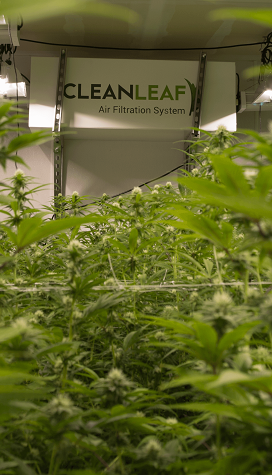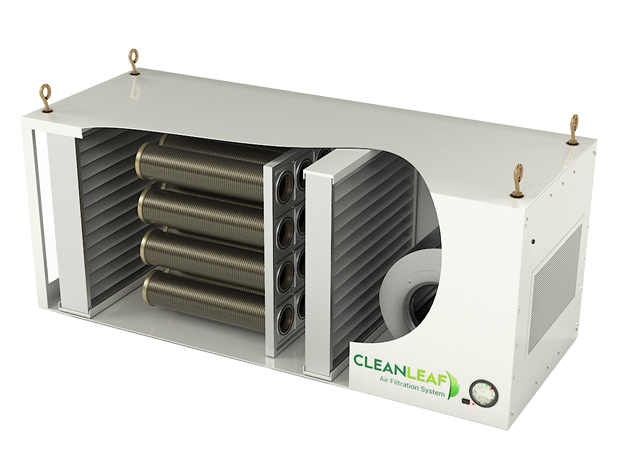Cannabis growers are faced with many unique challenges, one of the most difficult to overcome is odor control. Similar to other strongly aromatic plants, cannabis develops terpenes to attract pollinators and prevent predators through odor.
Terpenes are generally considered to be the major contributor to odor issues, but other compounds may be present in the exhaust from other indoor sources, for example, fertilizer and extraction processes (butane, propane).
Different fertilizer types will produce different combinations of gas emissions and require targeted carbons due to the small size of the gas compounds that may be present. These other odor sources are also commonly associated with more mainstream plant cultivation.
While many enjoy the smell, cannabis odors can present challenges for cultivators and neighboring communities and have been identified as a factor contributing to pollution.
The reality is that cannabis cultivation facilities must incorporate and maintain odor control measures to protect the crops and avoid complaints, shut-downs, or even lawsuits. While cannabis terpenes aren’t pollution, they are classified as VOCs because they evaporate easily and release molecules into the atmosphere.
Cannabis terpenes are one of many VOC sources but the molecules released can play a role in the production of ozone smog if not properly controlled.
In both Colorado and Washington, regulators attribute cannabis odor to air quality issues. Cannabis cultivation facilities in Denver County have increased the total VOC emission rate by up to 3.5% with terpene emissions estimated at 362 tons per year - representing more than half the emissions of the entire state.

As legalized cannabis cultivation and usage are introduced into communities across North America, there are state, regional, and local regulations being established to control cannabis odors through permits, property use, and nuisance rules.
Most states now require odor mitigation plans to apply for a license. Commercial grow facilities are being sued and even shut down due to violations, environmental concerns, and neighbor complaints.
Cultivators in multiple states including Colorado and California have been taken to court by neighbors for cannabis odor-related issues under the Racketeer Influenced and Corrupt Organizations (RICO) Act.
Why Carbon?
Proper odor control neutralizes grow room vapors and mitigates air contaminants. Choosing the most efficient odor control system depends on the demands of the grower and the cultivating process.
It's important to implement odor control systems that offer maximum effectiveness and efficiency.
To address the odor and environmental concerns associated with cannabis cultivation, the CleanLeaf Odor Control Series is specifically engineered to eliminate odor from even the most potent flowers, while protecting the health of the plants and people from other airborne threats such as mold and mildew.
Carbon is the most effective and efficient odor eliminator because of its organic structure. Activated carbon, in particular, is porous. It is designed to capture contaminants such as VOCs that are responsible for odors of all kinds. As the carbon pores become saturated, the VOCs are neutralized - eliminating odor at the source.
This effectiveness is corroborated by industry experts. According to the Colorado Department of Public Health and Environment - Air Pollution Control Division, "Carbon filtration is currently the best control technology for reducing VOC emissions from cannabis cultivation facilities."
As further emphasized by Caitlin D. Naske, Lead Chemical Engineer at Dynamic Air Quality Solutions, "the predominant choice for odor control in many grow facilities is activated carbon filters." This preference is well-founded, as Robovent, an industry expert, expounds on the benefits of activated carbon: “Activated carbon is the most commonly used adsorbent material. This is a form of carbon that has been specially treated (activated) to increase the internal surface area of the material. Activated carbon contains millions of internal “micropores” that result in a structure that provides ~1,000 or more square meters of surface area per gram of material. Activated carbon is widely available, affordable, biologically inert and safe to handle and use. It is often called the “universal adsorbent” because it can adsorb virtually any vapor or gaseous contaminant and can adsorb and retain many different chemicals at the same time. It is especially effective for organic molecules and solvents. Unlike some adsorbent materials, it does not retain moisture. These properties have made activated carbon the material of choice for a wide range of adsorption applications."
Additionally, growweedeasy.com underscores the effectiveness of carbon filters in marijuana grow rooms, noting that "Carbon filters (also called 'carbon scrubbers') will actually pull the smells out of the air, neutralizing any odors that pass through. Carbon filters are what you need if it’s important to neutralize the air coming out of your exhaust.
A good carbon filter will make sure you never accidentally leak the smell of cannabis out through a window into your neighborhood. These devices use activated carbon to chemically absorb smells and other impurities from any air that is pushed through the filter."
It’s important to remember that carbon air filtration does not mask odor, it captures - thereby eliminating - the source of any harmful or odorous VOCs.
Having acknowledged the effectiveness of carbon filtration in controlling odors in cannabis cultivation facilities, it becomes evident that several crucial considerations must be addressed when implementing these systems.
MTZ
Caitlin D. Naske, Lead Chemical Engineer at Dynamic Air Quality Solutions, offers insights into these vital aspects: “A critical activated carbon design factor that is often overlooked is mass transfer zone (MTZ). MTZ is the section of carbon where active adsorption is occurring, or more specifically, the depth of carbon needed for complete capture of the gas, at a given airflow and concentration. The MTZ is not only influenced by the type, concentration and number of contaminants, but also other design factors including the area of media and airflow through the media. The higher the concentration and/or air velocity, the longer the MTZ and the more depth that is required to prevent contaminant breakthrough and downstream odors.”
In short, the surface area of the filtration media must be big enough to adsorb the particulate as it is circulated through.
HVAC and Airflow
The ability for the filtration system to change the air in a room is critically important. The motor and fan in the air filtration unit must be powerful enough to change the air a particular amount of times in one hour (referred to as ACH = air changes per hour), depending on the size of the room.
Some cultivators will attempt to rely on their HVAC system to accomplish proper air filtration, but the truth is they're not powerful enough to filter cannabis odor molecules or contaminated air.
HVAC systems are built for heating and cooling the air and aren't equipped with the proper filter media, technology, or power to control grow-room odors. HVAC filters are simply designed to keep large particulates from affecting the internal mechanisms.
Responsible cultivators understand that more attention to detail is needed for proper air filtration and odor control.
When placed properly, air filtration systems should work in tandem to create vortex-like patterns that maximize airflow and more effectively capture odors and particulate. The air pattern is often called a “racetrack”. This prevents particulate from having the chance to settle in the grow room.
Additional Filtration
Additional layers of filtration are needed to achieve optimal air quality and to protect the carbon. From Caitlin D. Naske, Lead Chemical Engineer, Dynamic Air Quality Solutions: “Another simple and often forgotten way to maintain carbon performance is to install adequate pre-filtration to protect and prevent damage to the activated carbon. Debris can build up on the surface of the activated carbon over time reducing the carbon availability, inhibiting the adsorption of gasses and restricting air flow.”
With a thorough understanding of cannabis cultivation and more than 40 years of experience in air filtration, Air Cleaning Specialists created CleanLeaf to solve the unique and ever-growing challenges faced by cultivators and the individuals that are charged with the difficult task of regulating the industry.
Here’s how: There are a few options available to combat odor and contaminants in cannabis cultivation facilities, but many are designed to simply mask the issue, and worse, some actually emit byproducts that are harmful to humans and plants.
CleanLeaf units provide the safer, more effective and efficient solution using a powerful 2000 CFM blower to force air through a 4” pleated MERV 10 pre-filter, a 4” HEPA filter, 16 large carbon canisters and a 2" pleated after-filter to ensure maximum adsorption.
The completely self-contained units hang from the ceiling and are designed to work in teams to continuously circulate air, creating the “racetrack” airflow pattern to constantly adsorb odors and capture contaminants.

Stage 1: HEPA Saving Pre-Filter
Fiber Media | MERV 10
This pre-filter protects the HEPA filter from getting clogged with larger particulate. Should be changed every 6 months to 1 year.
Stage 2: HEPA Filter to Protect Carbon
HEPA Media | 95% D.O.P. @ 0.3 microns
This true medical-grade HEPA filter captures mold and mildew and other contaminants, protecting your crop from powdery mildew, cross-pollination and more. Should be changed every 6 months to 1 year.
Stage 3: Odor-Absorbing Carbon Canister
7 lbs. of Activate Carbon Per Canister
Each carbon canister is filled with 7lbs. of activated carbon. Made to capture and adsorb even the most stubborn odors from your crop. Should be changed every year.
Stage 4: Pleated After-Filter
Fiber Media | MERV 10
This after-filter gives the air one last step of filtration before circulating it back into your crop. Should be changed every 6 months to 1 year.
From odors to pollen to mold and mildew, CleanLeaf Air Filtration Systems has the solution to give your plants the air they deserve. Whether you’re growing in a greenhouse or a grow room, our industry experts are here to help you #GetYourAirRight
You may also like:
• Cannabis Microbes Regulations
• How to Maintain Grow Room Air Quality
• 10 Benefits of Grow Room Air Filtration